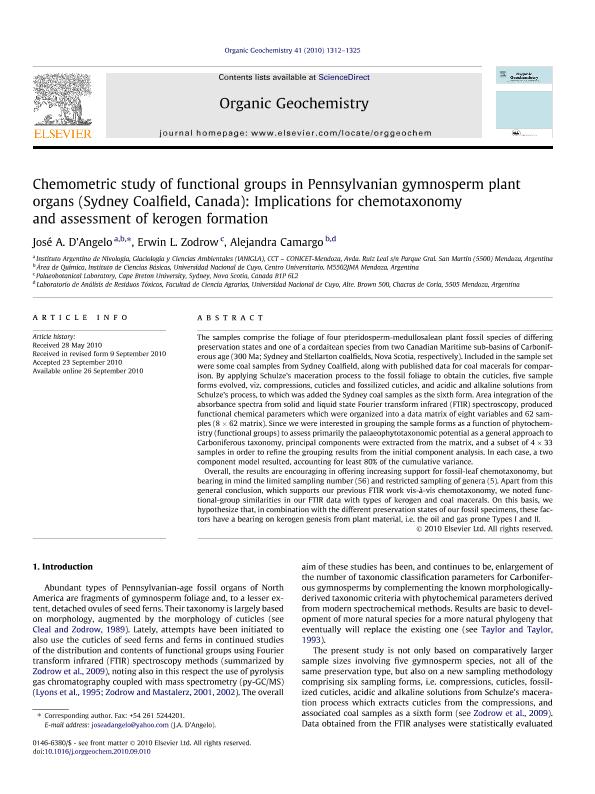Mostrar el registro sencillo del ítem
dc.contributor.author
D`angelo, José Alejandro

dc.contributor.author
Zodrow, Erwin L.
dc.contributor.author
Camargo, Alejandra Beatriz

dc.date.available
2020-06-10T18:26:19Z
dc.date.issued
2010-09
dc.identifier.citation
D`angelo, José Alejandro; Zodrow, Erwin L.; Camargo, Alejandra Beatriz; Chemometric study of functional groups in Pennsylvanian gymnosperm-plant organs (Sydney Coalfield, Canada): Implications for chemotaxonomy and assessment of kerogen formation; Pergamon-Elsevier Science Ltd; Organic Geochemistry; 41; 12; 9-2010; 1312-1325
dc.identifier.issn
0146-6380
dc.identifier.uri
http://hdl.handle.net/11336/107211
dc.description.abstract
The sample specimens for study comprise the foliage of four pteridosperm-medullosalean plant-fossil species of differing preservation states and one of a cordaitean species from two CanadianMaritime Sub-Basins of Carboniferous age, 300 Ma, i.e., Sydney and Stellarton coalfields in Nova Scotia, respectively. Included in the sample are some coal samples from Sydney Coalfield, and published data of coal macerals for comparisons. By applying Schulze´s aceration process to the fossil foliage to obtain the cuticles, five sample forms evolved, viz. compressions, cuticles, fossilized cuticles, and acidic and alkaline solutions from Schulze´s process to which is added Sydney´s coal samples as form 6. Area integration under the absorbance curve of spectra from solid and liquid state Fourier ansform infrared (FTIR) spectroscopy, produced functional chemical parameters which were organized into a data matrix of eight variables and 62 samples (8x62 matrix). Since we are interested in groupings ofthe sample forms as a function of phytochemistry (functional groups) to assess primarily the palaeophytotaxonomic potential as a general approach to Carboniferous taxonomy, principal components were extracted from that matrix, then using a subset of 4x33 samples in order to refine the grouping results of the initial component analysis. In either case, a two-component model resulted, accounting for least 80% of cumulative variance in either case. Presented are results of the various analyses, which overall, are encouraging in offering increasingsupport for fossil-leaf chemotaxonomy, realizing at the same time our limited sampling number (56) and small sampling of genera (5). Apart from this general conclusion, which supports our previous FTIR work vis-à-vis chemotaxonomy, we noted functional-group similarities in our FTIR data with types of kerogen and coal macerals. On this basis, we hypothesize that in combination with the different preservation states of our fossil specimens these factors have a bearing on kerogen genesis from plant material, i.e., the oil and gas prone Types I and II.
dc.format
application/pdf
dc.language.iso
eng
dc.publisher
Pergamon-Elsevier Science Ltd

dc.rights
info:eu-repo/semantics/openAccess
dc.rights.uri
https://creativecommons.org/licenses/by-nc-sa/2.5/ar/
dc.subject
Carboniferous
dc.subject
Compression-cuticles
dc.subject
Schulze's solutions
dc.subject
FTIR
dc.subject
chemotaxonomy
dc.subject.classification
Química Analítica

dc.subject.classification
Ciencias Químicas

dc.subject.classification
CIENCIAS NATURALES Y EXACTAS

dc.title
Chemometric study of functional groups in Pennsylvanian gymnosperm-plant organs (Sydney Coalfield, Canada): Implications for chemotaxonomy and assessment of kerogen formation
dc.type
info:eu-repo/semantics/article
dc.type
info:ar-repo/semantics/artículo
dc.type
info:eu-repo/semantics/publishedVersion
dc.date.updated
2020-05-11T16:48:11Z
dc.journal.volume
41
dc.journal.number
12
dc.journal.pagination
1312-1325
dc.journal.pais
Canadá

dc.journal.ciudad
Sydney
dc.description.fil
Fil: D`angelo, José Alejandro. Universidad Nacional de Cuyo. Facultad de Ciencias Exactas y Naturales; Argentina. Consejo Nacional de Investigaciones Científicas y Técnicas. Centro Científico Tecnológico Conicet - Mendoza. Instituto Argentino de Nivología, Glaciología y Ciencias Ambientales. Provincia de Mendoza. Instituto Argentino de Nivología, Glaciología y Ciencias Ambientales. Universidad Nacional de Cuyo. Instituto Argentino de Nivología, Glaciología y Ciencias Ambientales; Argentina
dc.description.fil
Fil: Zodrow, Erwin L.. Cape Breton University; Canadá
dc.description.fil
Fil: Camargo, Alejandra Beatriz. Universidad Nacional de Cuyo. Facultad de Ciencias Agrarias. Departamento de Ciencias Enológicas y Agroalimentarias. Laboratorio de Residuos Tóxicos; Argentina. Consejo Nacional de Investigaciones Científicas y Técnicas. Centro Científico Tecnológico Conicet - Mendoza; Argentina
dc.journal.title
Organic Geochemistry

dc.relation.alternativeid
info:eu-repo/semantics/altIdentifier/doi/http://dx.doi.org/10.1016/j.orggeochem.2010.09.010
dc.relation.alternativeid
info:eu-repo/semantics/altIdentifier/url/https://www.sciencedirect.com/science/article/abs/pii/S0146638010002354
Archivos asociados
